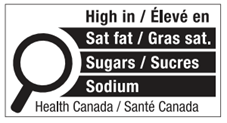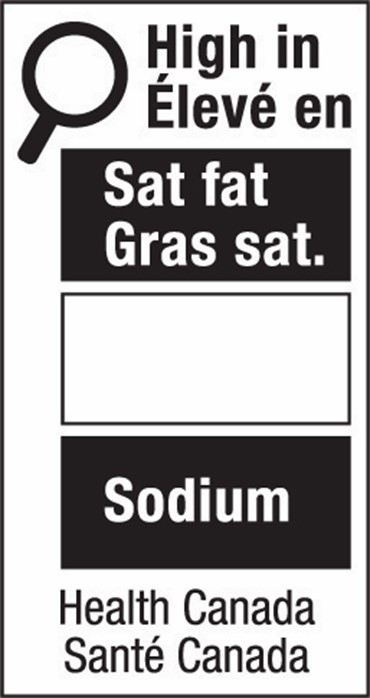Canadian Front-of-Package Nutrition Symbol Labeling
Labeling compliance is a detail-oriented and deeply litigious process, but absolutely necessary to pull off in order to protect your consumers from harm and your manufacturing facilities from improper products. In particular, Canada nutrition symbol labeling has been updated to target specific health concerns in the country.
Health Canada enacted changes to front-of-pack (FOP) labeling; these came into effect July 20, 2022 and give companies until January 1, 2026, to make the necessary changes. Businesses need to take particular care to understand the nuances of the new laws and ensure full compliance in line with the given timeline from the Canadian government.
Considerations for FOP Canada Nutrition Symbol Labeling
Health Canada published additional FOP nutrition labeling regulation requirements for pre-packaged foods that meet or exceed defined thresholds for the nutrients of saturated fat, sugars, and/or sodium. These nutrients are considered nutrients of concern because the evidence demonstrates high intakes of saturated fat, sugars and/or sodium can contribute to various diseases, such as obesity, heart disease, type 2 diabetes, and high blood pressure.
The new FOP symbol is black and white, features a magnifying glass, and is presented in both English and French (see Figure 1). However, there are provisions for using two separate symbols, one in English and one in French. The design and associated specifications for each symbol format are set out in the directory of Canada nutrition symbol labeling specifications.

The required size of the symbol is related to the size of the package and must be displayed on the principal display panel (PDP). When the height of the PDP is greater than the width, the symbol must be displayed within the upper half (50%) of the PDP. When the height of the PDP is less than the width, the symbol must be displayed within the right half (50%) of the PDP. Cylindrical containers also have some special rules for the space permitted for the display of the symbol. The symbol cannot appear in the left-most and right-most 10% of the PDP. Helpful examples for placement can be found in the front-of-package Canada nutrition symbol labeling guide for the industry.
The symbol has to be oriented in the same direction as most of the other information that appears on the principal display panel. The horizontal format is the default orientation so a majority of the products that need to carry the symbol will have that format. The use of the vertical format is required when the product has a principal display surface (PDS) less than or equal to 450 square centimeters and the horizontal format is wider than the PDP (see Figure 2).

Reasons for FOP Labeling
Only those prepackaged foods that meet or exceed the prescribed levels for saturated fat, sugars, and/or sodium will need to include an FOP symbol. Additionally, only the nutrients that meet or exceed the thresholds will need to be listed in the symbol. For packages with sufficient space (a principal display surface greater than 30 square centimeters), nutrients that don’t need to be declared will have blank bars as placeholders.
Foods that will require a FOP nutrition symbol include:
- Prepackaged foods that meet or exceed 15% DV of saturated + trans fat, sugars and/or sodium
- Prepackaged foods with a small reference amount (< 30 g or mL) that meet or exceed 10% DV of saturated + trans fat, sugars and/or sodium
- Prepackaged main dishes with a reference amount of > 200 g (170 g for children one to four years of age) that meet or exceed 30% DV of saturated + trans fat, sugars and/or sodium
Calculations are based on the amount of the nutrient in the serving size or reference amount of the food, whichever is greater. For products that require reconstitution or the addition of other ingredients for preparation and the reference amount only refers to the food in its prepared form, the percentage of daily value is calculated on the basis of the amount of the nutrient per serving of stated size.
Exemptions from FOP Labeling
Health Canada is exempting certain foods from the FOP nutrition symbol requirement. But keep in mind that the exemption can be lost in certain situations such as making nutrient claims on the product or adding ingredients that are sources of saturated fats, sugars and/or sodium. Examples of exemptions are as follows:
- Foods that have a recognized health protection benefit such as fresh, frozen, canned or dried vegetables and fruits, 2% and whole milk, eggs, and foods with a healthy fat profile (less than 30% of the total fat content consists of saturated fat) such as nuts and fatty fish.
- Foods that are important sources of shortfall nutrients — those that are not readily available in other foods and that most people in Canada don’t get enough of. For example, calcium in dairy products that have not had saturated fat or sugars added.
- Foods that are formulated to meet the needs of specific populations such as rations for military personnel use.
- Foods that do not require a nutrition facts table such as whole cuts of meats, poultry and fish.
- Raw, single ingredient ground meats and poultry due to the whole cuts being exempt.
- Foods that are not sold directly to consumers and those in very small packages.
- Foods on which the nutrition symbol would be redundant, such as packages of sugar, honey, maple syrup, table and flavored salt, butter and other fats and oils.
Most nutrition and health-related statements and claims may be made on the label or in advertisements for foods even when the food must carry an FOP nutrition symbol. However, there are some restrictions. It would not be appropriate, for instance, to make an “unsweetened” claim when the PDP carries a symbol for “high in sugars.” Nor would it be appropriate to claim a food can be used in a sodium-restricted diet when the PDP carries a symbol for “high in sodium.” Also, if the PDP carries a FOP nutrition symbol for “high in” one of the three nutrients, you would not be able to make any nutrient content claims for that nutrient, except for “reduced in” claims if applicable. The final regulations also address maximum font sizes for nutrient content claims on the PDP when the FOP nutrition symbol is present.
Ensuring Canada Nutrition Symbol Labeling Compliance
Whether conducting business in Canada or importing to or exporting from the country, food and beverage manufacturers need to guarantee they stay fully compliant with all regulations. Explore AIB International’s labeling reports to leverage in-house expertise on how to adhere to these ever-changing laws — securing your company from fraud or fines.


